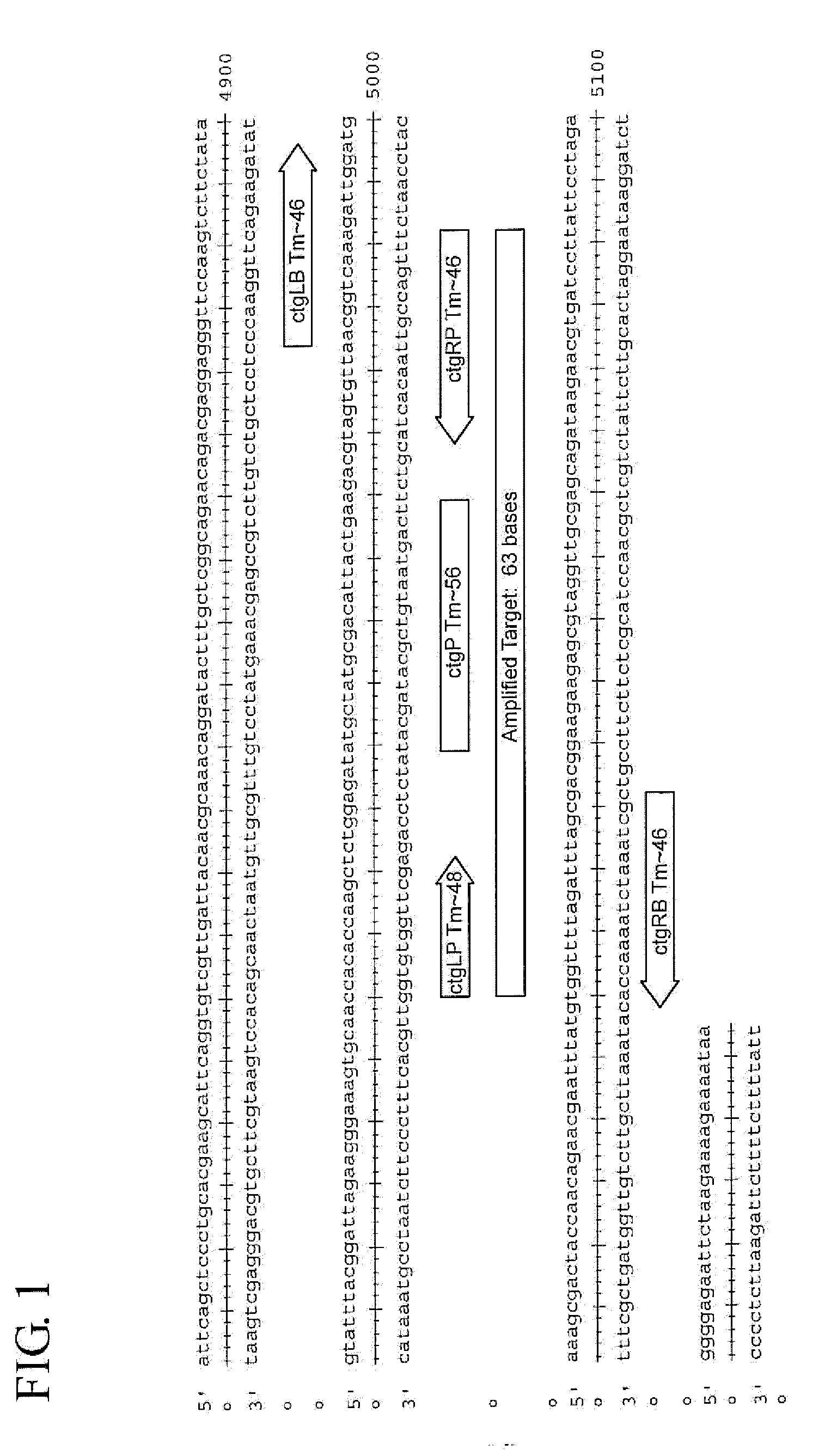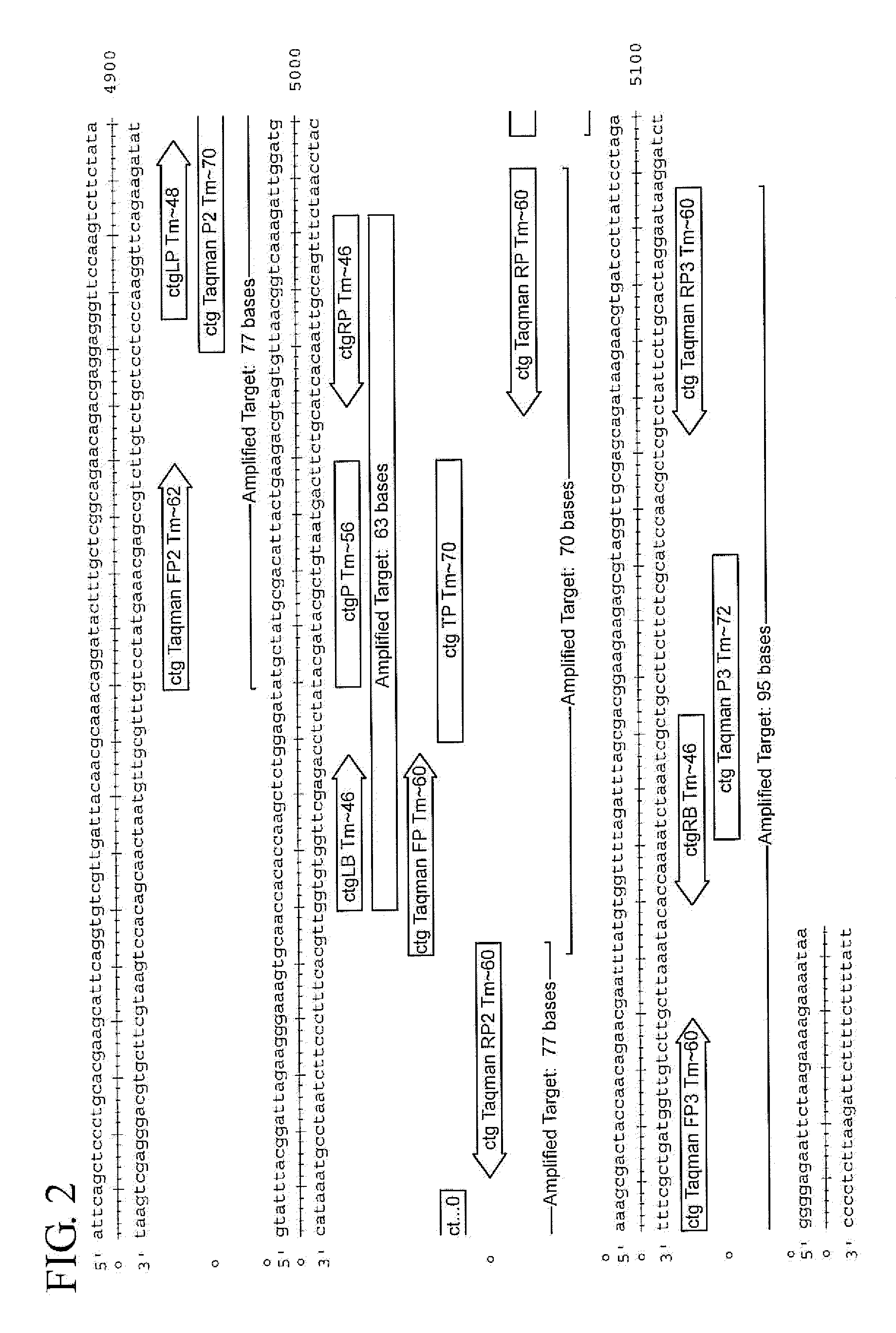Assay for Chlamydia trachomatis by amplification and detection of Chlamydia trachomatis cytotoxin gene
a technology of chlamydia trachomatis and cytotoxin gene, which is applied in the field of chlamydia trachomatis by amplification and detection of chlamydia trachomatis cytotoxin gene, to achieve the effect of facilitating the detection of the target dna sequen
- Summary
- Abstract
- Description
- Claims
- Application Information
AI Technical Summary
Benefits of technology
Problems solved by technology
Method used
Image
Examples
example 1
Evaluate Analytical Sensitivity and Specificity Using Viper SP Chemistry
[0084]Analytical sensitivity in a UPT urine system was determined using the Viper SP system. Specificity and cross-reactivity testing was performed using a panel of CT serovars and closely related non-CT organisms. The SDA systems that target the CT chromosome were tested on the Viper SP platform with spiked sample matrices. The limit of detection (LOD) was determined in UPT Urine samples. Preliminary screening results for the cytotoxin gene assay indicate that it is sensitive to <30 EB / mL in vaginal matrix. The results are shown below in Table 4.
TABLE 4Limit of Detection (EB / mL)TargetClean SystemVaginal MatrixUPT UrineCytotoxinNot performedNot performed38 (95% CI:gene28, 48)
example 2
Assay Specificity
[0085]The SDA systems that target the cytotoxin gene region of the CT chromosome were tested against a panel of CT serovars (table 5) and 17 closely related non-CT organisms (table 6).
TABLE 5ConcentrationCytotoxinOrganismID(EB / mL)gene AssayCT Serovar AATCC VR-571B1.00E+02positiveCT Serovar BATCC VR-5731.00E+02negativeCT Serovar BaATCC VR-3471.00E+02negativeCT Serovar CATCC VR-5721.00E+02positiveCT Serovar DATCC VR-8851.00E+02positiveCT Serovar EATCC V-248B1.00E+02positiveCT Serovar FATCC VR-3461.00E+02positiveCT Serovar GATCC VR-8781.00E+02positiveCT Serovar HATCC VR-8791.00E+02positiveCT Serovar IATCC VR-8801.00E+02positiveCT Serovar JATCC VR-8861.00E+02positiveCT Serovar KATCC VR-8871.00E+02positiveCT Serovar LGV2ATCC VR-902B1.00E+02positiveCT Serovar LGV3ATCC VR-9031.00E+02positive
TABLE 6ConcentrationCytotoxinOrganismID(cells / mL)gene AssayC. psittaciCal-105.00E+06negativeC. pneumoniaeAR395.00E+07negativeNeisseria gonorrhoeaeATCC 194243.70E+08negativeMoraxella lac...
example 3
Taqman PCR System for Detecting Cytotoxin
[0088]Sets of Probes were designed to perform Taqman PCR on the highly conserved region. TaqMan real-time PCR is a type of quantitative PCR. TaqMan uses a fluorogenic probe which is a single stranded oligonucleotide of 20-26 nucleotides and is designed to bind only the DNA sequence between the two PCR primers. In TaqMan, reporter dyes and quencher dyes are attached to the probe. The probe is annealed to the DNA by alternating the temperature to denature and re-anneal the DNA. The Taq polymerase adds nucleotides to the target DNA and this removes the Taqman probe from the template DNA. When the reporter dye is separated from the quencher dye, the reporter dye emits energy which is detectable. The energy is quantified by a computer, which provides a signal indicating that the target was detected. Only the specific PCR product can generate the fluorescent signal in TaqMan PCR.
[0089]To practice TaqMan PCR, two PCR primers with a preferred product...
PUM
| Property | Measurement | Unit |
|---|---|---|
| temperatures | aaaaa | aaaaa |
| temperatures | aaaaa | aaaaa |
| temperatures | aaaaa | aaaaa |
Abstract
Description
Claims
Application Information
 Login to View More
Login to View More - R&D
- Intellectual Property
- Life Sciences
- Materials
- Tech Scout
- Unparalleled Data Quality
- Higher Quality Content
- 60% Fewer Hallucinations
Browse by: Latest US Patents, China's latest patents, Technical Efficacy Thesaurus, Application Domain, Technology Topic, Popular Technical Reports.
© 2025 PatSnap. All rights reserved.Legal|Privacy policy|Modern Slavery Act Transparency Statement|Sitemap|About US| Contact US: help@patsnap.com


